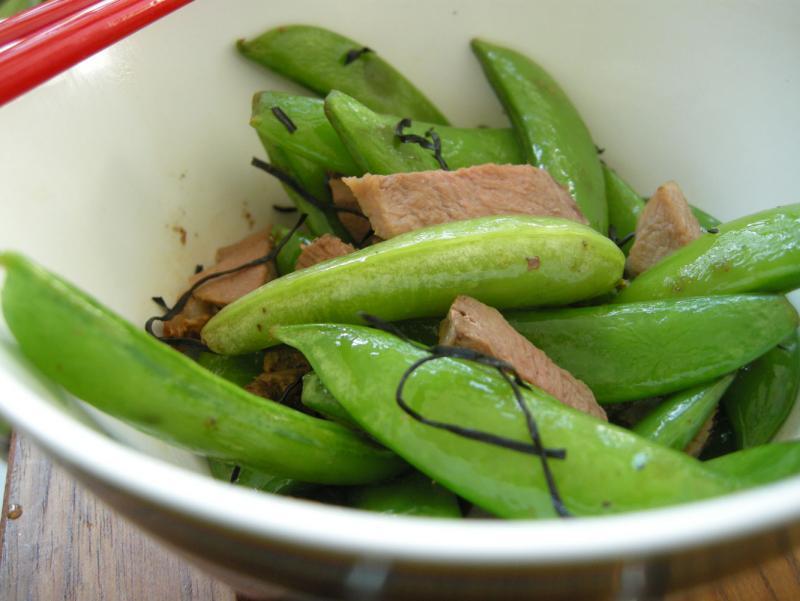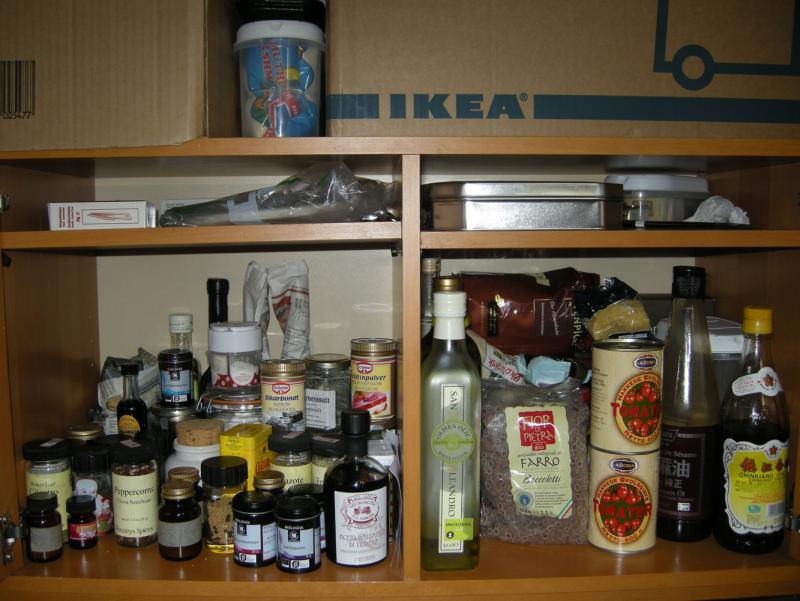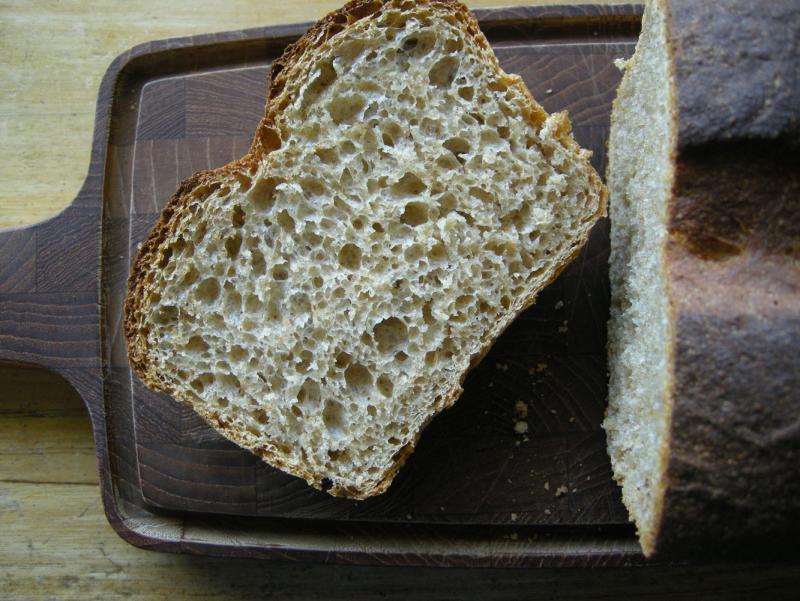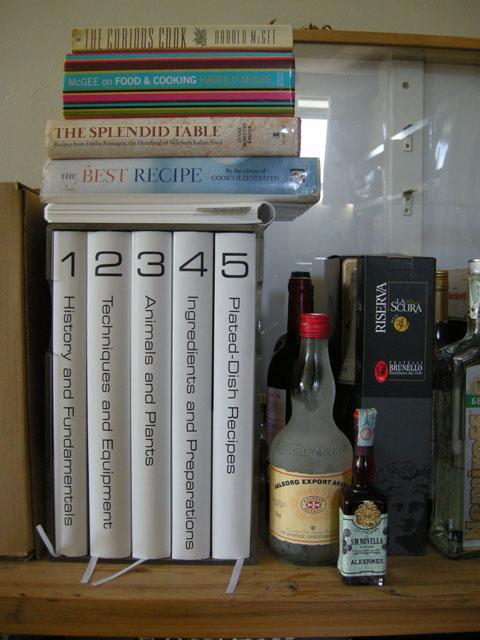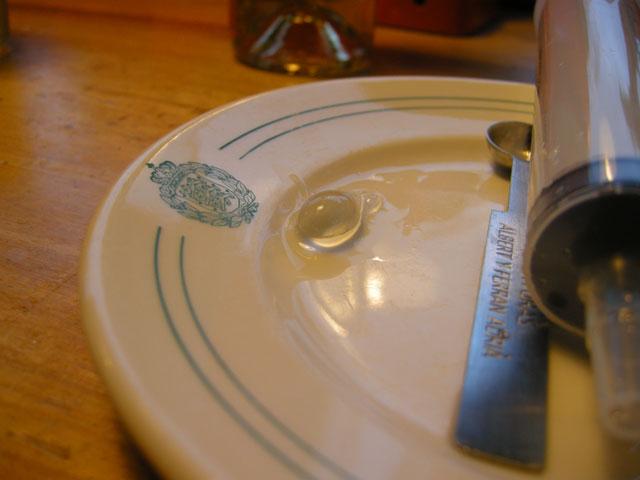-
Posts
7,657 -
Joined
Content Type
Profiles
Forums
Store
Help Articles
Everything posted by Mjx
-

eG Foodblog: Mjx (2012) – Elderflowers, Strawberries, and Game
Mjx replied to a topic in Food Traditions & Culture
Hm, well, this is actually being kind of fun (I was pretty nervous about this). Yes, that's 100% spelt, a 2:3 combination of sifted and semi-sifted flours, and only the top gets oiled. A starter would be great if I knew I could always count on giving the bread a long enough rising time, but that's just not an option. What usually happens is one minute, there's about half a loaf, and suddenly, there's no bread, so I need to put together a loaf that doesn't demand more than a couple of hours, start to finish. I'm curious, which celebrity baker is big on spelt? -

eG Foodblog: Mjx (2012) – Elderflowers, Strawberries, and Game
Mjx replied to a topic in Food Traditions & Culture
I have hopes of the Wednesday/Saturday market I cooked the duck breast for breakfast, and about half was left over, so that's going into tonight's dinner. The seawead was mostly for crunch; it's surprsingly neutral-flavoured. I was looking at the duck and peas, and thought 'Needs something', so I reached for the jar of seaweed. I get the impression that a long time ago, various seaweeds species were eaten in Denmark (pretty much as they were by a lot of coastal cultures), but no one does it anymore. No one I've asked really seems to know! -
It all looks lovely, but please tell me about the oyster pebbles. They look like macarons with..?
-

eG Foodblog: Mjx (2012) – Elderflowers, Strawberries, and Game
Mjx replied to a topic in Food Traditions & Culture
Today makes for a quiet start, because my boyfriend went to Sensation Amsterdam with a friend of ours, and won’t be back until late this evening. When I’m on my own, I tend to wait until about 11.00 or so before having breakfast (and don’t usually eat lunch). Today’s breakfast, peas, duck breast, and arame: As usual, this was followed by a lot coffee, which I drink absentmindedly while I work (I’m self-employed, so if I’m at home, I don’t do ‘days off’, unless I have no work at the moment). I bake bread about twice a week, usually spelt or spelt and rye, which began when I optimistically hoped that I tolerated spelt better than wheat. My boyfriend (now the principal bread eater) discovered that he actually preferred spelt bread, so I never switched back to ordinary wheat flour. Since we're clean out of bread, baking is on today's agenda. Most of the time I use a reworked version of The Best Recipe’s sandwich bread recipe (since most of it ends up as sandwiches). I scrapped the sugar, since neither of us likes sweet bread, and either use no fat, or olive oil instead of melted butter (this is due to unrelenting sloth on my part). My basic recipe is 500g/17.6 oz. flour, a cup and half/355 ml of water, 3–5 g/0.1–0.18 oz salt, and 10g/0.35 oz fresh yeast. After proofing the yeast, I just mix everything together and let it sit about 20 minutes (a sort-of autolyse, but with all the ingredients), to give the flour time to absorb water, then use a hand mixer until the consistency feels right. This gives me a very loose dough: Once it’s risen, I transfer it to a loaf pan, oil the surface, and let it rise again. I slash the top with scissors, bake it for 20 minutes with a pan of water, then about half an hour longer (I really need to keep an eye on this oven, since it tends to have weird heat spikes than can char things in just a few minutes) with the convection on. This is the quick-and-dirty version: often, I have to fit bread-baking around a tight work schedule, so this is pretty stripped down. When there’s time, I extend one or both rises, but even when that doesn’t happen, I’m surprised by how well it comes out, so I’m quite grateful to The Best Recipe for this one. A bit of contortionism made it possible for me to get this shot of the cabinets (although the angle kind of makes it look like the shelves are melting): -
It feels a bit strange to say 'Welcome to Denmark!', since I'm not Danish, did not grow up here, and find Danish food culture (my boyfriend, who is Danish, began laughing when I told him about wanting to reconsider traditional Danish food this week) kind of elusive. However, this is where I'm blogging from, so... welcome to Denmark! I'm afraid that first teaser image threw people off track, although Kerry was right, it's a rape-seed field in bloom, the dominant note in the Danish landscape in late spring. I took the picture while sitting on the pillion; just leaned a bit to the side, so I could see around my boyfriend's helmet, and took the shot (that's his hand you see). The second image is the Roosevelt Island Tramway station on the Roosevelt Island side: I was born in New York City (making me a third generation American/New Yorker), although my parents moved to Italy when I was a baby. I grew up in Florence, and the Tempio Maggiore is one of my favourite buildings; we often walked around its garden, on the way to a nearby park. Growing up in Florence had a major effect on my food preferences, the way I shop and prepare food, and the way I feel about food (having American parents who became vegetarian and inclined to health foods affected the way I think about food). Next image: My boyfriend gave me Modernist Cuisine for my birthday! I've only had it for a month, and I'm still in the 'Oooooh, look...' phase (although the 'Holy crap, how do I afford even the smallest pieces of necessary equipment?!' phase has begun). That's essentially my entire collection of cook books, there. I also have a stack of Cook's Illustrated, and some small books on Tuscan and Florentine cooking, but that's pretty much it. I have a really strong aversion to things that just take up space, so I don't get a cook book unless I'm quite certain I'll really use it. The globule on the plate is one of the more successful 'spheres' from my first effort at spherification. Mostly I got a lot of weird looking slime, but it was fun, anyway, and I learned a something. I'm thinking of giving this another go, this week. The last image is from Grenen, up in Skagen, which it is the northernmost point of Denmark. Virtually every one of the people standing in the water got someone to photograph them standing approximately where the guy nearest the horizon is, then went home to show their friends and family, and explain that they were standing in two bodies of water at the same time: the Skagerrak to the north, and the Kattegat to the south (the turbulent area is where the two bodies of water meet). The two seasons in Skagen are 'inhospitable', and 'packed to the rafters with tourists'. Where I am is a good way south of here, on the east coast. My cooking tends to have Tuscan roots (simple, lean) overlaid by a thick slab of experimental geekery (currently curtailed because the kitchen I'm using is not my own), and adapted to accommodate local ingredients/conditions, sudden whims, and a complex array of food sensitivities and preferences (mine and my boyfriend's). So that's the background. To fill in a bit more about where I am, Denmark runs to cool, wet summers, which means that things like home grown tomatoes are still off in the future. Our plants haven't even set flowers, yet (we did start them a bit late): We also have a couple of chili plants. One seems to be going all out with blossoms and is setting fruit, the other has not a one, which may be entirely normal. The kitchen situation here is a little unusual. We're temporarily staying with my boyfriend's parents, since we sold our flat, but are still hunting for a suitable replacement. Here's their kitchen: I try not to take over the kitchen, so I plan around what and when my boyfriend's parents use it. Also, I mostly use my boyfriend's parents pots, pans, and utensils, since our own kitchen is mostly in boxes, apart from the little bit I've unpacked (there just isn't room to unpack much, and packing and repacking gets old really fast). I tried to take some shots of the inside of the cabinets where I store the things I did unpack, then realized that I wasn't able to get more than about a half metre back from them, and couldn't get a clear shot (there's the also thing with needing a flashlight to see things in there). This setup presents a few challenges, so most of what I cook these days is not particularly ambitious. To be honest, I've let myself fall into a rut, which I'm planning on hauling myself out of, this week. You can probably count on at least one spectacular culinary disaster (if that doesn't happen, I will happily share my images of the apple pie fiasco of this past New Year's Eve <<<shudder>>>). If you have questions or suggestions, fire away!
-
Manicures are wonderful, but only if you are dead certain the place you go to has extremely effective hygiene practices; the risk of contracting a fungal infection is very real (and an even greater issue if your hands are more vulnerable than most people's to begin with). Even places that honestly try to follow proper protocols may not necessarily effectively do. If you have any doubts, you're best off getting together with a friend, and giving each other manicures. Nail polish can cut both ways: it might protect the outer surfaces of the nails a little, but will hold in moisture, and that's probably not great, under the circumstances For whatever it's worth, when I've had jobs that involved an unusual amount of hand-washing, I've usually reached for plain petrolatum (Vaseline); the important thing is to use very small amounts, adding a tiny bit more, if necessary. I always apply it to the back of one hand, rubbing the two backs together, then make a special point of really working it well in around the entire edge of each nail, and finishing by rubbing the palms very lightly over the backs of the hand (the amount picked up is so small, the palms don't feel greasy). I do this fairly often, every few washes. I love Corn Huskers, but it simply can't replace the normal skin oils that are stripped away by constant, vigorous washing.
-

Guilty Pleasures – Even Great Chefs Have 'Em – What's Yours?
Mjx replied to a topic in Food Traditions & Culture
Adding to the starch sandwich madness, I have to mention my personal favourite, pita stuffed with falafel and chips (fries/pommes frites, that is, not crisps). No dressing, no leaves, just the starch, the whole starch, and nothing but the starch. But I can't say I feel guilty about eating this, or any other food, as such (and I'm capable of feeling guilty about virtually anything, including binning a decrepit oven mitt that has seen long service). -
Okay: Just to extract the main point, what is the modernist cooking tip we're talking about, here? Because I have to admit the only tip I've extracted is 'avoid About.com', but... I already knew that
-
It's getting harder and harder to find chinotto soda... in Italy, dammit.
-

Guilty Pleasures – Even Great Chefs Have 'Em – What's Yours?
Mjx replied to a topic in Food Traditions & Culture
Does eating Nutella straight (well, I use a spoon) from the jar count? Or is that more 'Hall of Shame' material? -
Wait: I was told that if you have things growing on it, it isn't a compost heap, but a tip for green waste, since the end-product of composting is supposed to be this black, soil-like stuff. Is 'compost' now a broader term than when I was a kid (and my mum would hold forth at length on this subject at mind-numbing length)? ETA: I see that heaping up green waste without containing it in something that raises the internal temperature is 'cold composting'; don't think I knew that.
-
What makes you think they are thinking about accuracy at all? This is all about convenience (or at least, the appearance of convenience, since of course it's really all about selling more Pyrex!). The reviewers on amazon.com seem happy with the thing, and to be honest, when I need precision in measuring liquids I go by weight anyway. I only use my Pyrex for casual liquid quantities where a half ounce here or there doesn't affect anything. I have to admit I trust lab glassware as much as I trust a scale (and I'm big on using scales), since labs still do use the stuff, and it isn't for want of available scales. But agreed, the updated model is all about selling more Pyrex.
-
Meh. When I see this feature on lab glassware, I'll consider the possibility that it might be a good idea. When I read about this in Cook's Illustrated last summer, I really wondered what they were thinking, since it just doesn't like a good way to optimize accuracy.
-
In Italy they have a good number of museums dedicated to various specialties (e.g. Prosciutto di Parma), and it seems likely that this holds true for the countries you mention, so if you do an online search for {[some regional specialty] museum/musée/museo}, you should come up with quite a few options.
-
The thought crossed my mind (about the lime juice/oils), since I know oil of orange is used in compounds designed for removing graffiti, but I figured you must have had these things in the blender before..?
-
Sounds to me like the dishwasher [detergent] is reponsible, unless (as far as you can see) the cloudiness is only on the inside. Then, I have no idea.
-
I almost always salt before (often, a standard or a 'dry' brine) but this does depend on the results you want (discussed, in the Salt meat before or after you cook? topic, and a search should turn up more). Science? Something to do with salt concentration and diffusion (courtesy of Harold McGee's works, Cook's Illustrated, and Modernish Cuisine), but I'm afraid I don't recall the details accurately, offhand.
-
According to Cook's Illustrated (January/February 2012 issue) croissants turn out better with cultured (aka 'European style') butter, so that would be a brilliant use for it. In general, baked goods made with cultured butter taste much more of butter (it also contains less water, so it can change certain textures). I'm in the EU, and the only butter available is cultured, which is great, but does sometimes mean I need to tweak recipes a bit. For example, the first time I made brownies with it, they tasted more like butterscotch bars, and I had to adjust the recipe to bring the chocolate back to the foreground.
-
You might want to keep in mind that almonds are a bit over 21% carbohydrate, and half of that is in the form of sugars or starches.
-

How To Handle Excessively Loud (obnoxious) Diners at the Next Table
Mjx replied to a topic in Restaurant Life
There's nothing you can do, unless you look really, really scary (i.e.scary enough to frighten a bunch of drunks by just striding over to their table and quietly saying, 'Shut up. STAY shut up'). Are you two metres tall, a metre wide, have stainless-steel teeth, and look as though you moonlight as a public executioner somewere? No? Trust me, you don't look scary enough. If the restaurant won't do anything about this sort of thing, you're pretty much screwed. For whatever it's worth, I won't dine anyplace with a TV visible anywhere on the premises; it's a red flag. -

Bread Puddings: Because stale hot dog buns are a certainty regardless.
Mjx replied to a topic in Pastry & Baking
Xanthan gum might do it, although I don't know how pleasant the texture would be, but before you start looking into this, check the ingredient list on those hot dog buns, if you're planning on using them; they often contain eggs/dairy. -
Is it unusual that they didn't have Jamón Ibérico? Are many Spanish food items in popular demand/widely available in China? If it isn't unusual to not be able to find Spanish foods in China, it isn't exactly inexplicable to not find Jamón Ibérico at Walmart!
-
If you've looked into this already, apologies, but are there any locally available forms of laminaria species? Relatively speaking, Australia has a pretty long coastline, I'd figure somewhere along it the water would be clean enough to harvest kombu, or a related species, if it grows there, in which case some shops might carry it (health foods shops, that sort of thing).
-
There are people who still believe that menstruating women prevent sauces from thickening. I don't hold much credence in personal observation unless backed by at least some degree of rigorousness. For a long time, many people assumed that the "stall" observed in BBQ cooking was due to collagen conversion. While collagen conversion does occur and does take some amount of energy, the observed amounts were orders of magnitude too low to account for stall. It wasn't until Mhyrvold and a couple of other scientists decided to test it that we finally figured out it was almost entirely due to evaporation. Quite a jump there, from 'observation' to 'statement', since no one can accurately say they've 'observed' that the presence of menstruating women has any effect on food whatsoever; that sort of statement is a 'belief' (if you want to be charitable; 'a lie', 'imbecilic notion', or 'indication of insanity', if you're not feeling charitable), and has no basis in observation, scientific or otherwise. If I say 'I've observed that the flavour of stews alters overnight', that is an actual observation. if I say, 'I've observed diffusion/oxidation in stews', you'd be completely justified in saying that unless I've correctly used a variety of pieces of equipment to observe and document this, I'm a liar/idiot with no grasp of English. I could say that I've read in a reliable source that this takes place, but frankly, I don't believe that I have read about this occuring in stews, specifically. On the other hand, I have observed diffusion in various substances (using dyes and so on on) in chemistry classes, and it seems reasonable to extrapolate the laws of chemistry from the classroom to the kitchen.
-
Actually, if you're describing something as being based on your experience, peer review is by no means required. I'm picky as hell about accuracy (I make my living nitpicking), but these days, even less-than-attentive school children are aware of the phenomena of diffusion and oxidation.


